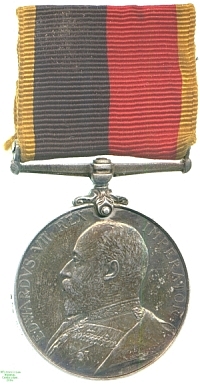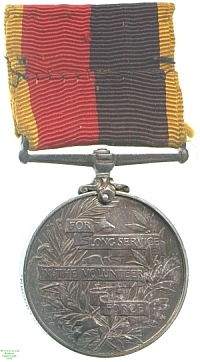
Obverse, a bust of King Edward VII

Reverse, the inscription on a scrolled banner with a wreath behind

Obverse, a bust of King Edward VII |

Reverse, the inscription on a scrolled banner with a wreath behind |
In its origins an unofficial organisation by the City of London for its defence, first recognised by royal charter in 1537, the Honourable Artillery Co. of London is reckoned the oldest regiment of the Royal Army, although it was only formally placed under state control in 1860. In 1907 the Company as a whole was taken into the Territorial Reserve, now the Territorial Army of which it is still a part. Though very much an association first and a military unit second the Company has won numerous battle honours and currently performs surveillance for the NATO Rapid Reaction Force.
Prior to 1908, units that in that year made up the new Territorial Reserve had been distributed between the Militia, volunteer battalions assigned to existing regular units, and the Volunteer Force, a separate organisation with its own structure, as part of which the Honourable Artillery Co. was reckoned. By the 1890s, the issue of long service and good conduct awards for the Army and Navy was well-established, and the institution of awards for their dependent services had begun. The Volunteer Force received its first Long Service medals in 1894, but by administrative oversight the Honourable Artillery Co. was not made eligible for it until 1906. To compensate the venerable regiment for this mistake, the Volunteer Force Long Service Medal that it was issued with was given a special ribbon to distinguish it from the regular issue.
This example of the HAC's Long Service Medal was awarded to Sergeant Trumpeter W. J. Waterlow, one of its stalwarts and a member of its veterans' association. It is one of three medals that were awarded to him that are now in the Watson Collection; the others precede and follow this one. The medals are not attached to each other so although the Watson Collection catalogue considers them as Group 5 they have been treated separately here. Nonetheless, it was as a group that Lester Watson purchased them at some point before 1928; they had all previously formed part of the Payne Collection.